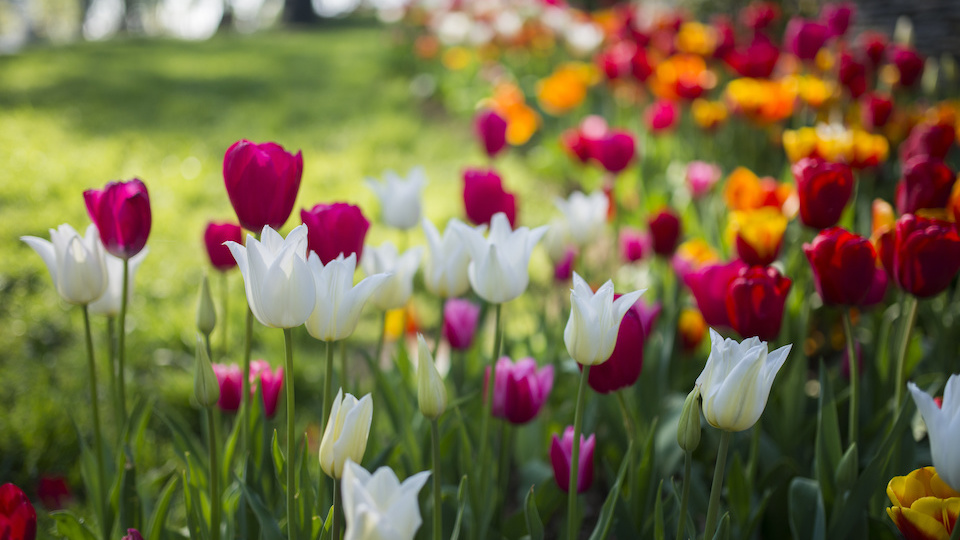There’s nothing quite so rewarding as seeing all of your hard work in the fall finally pay off with beautiful spring blooms once the cold weather has finally passed. Instead of just looking at bare trees and dead grass, like you have been all winter, these colorful blooms will give you something to look forward to and remind you that summer is on the way!
English bluebells
This hardy, yet delicate-looking flowers create an exquisite light blue carpet that helps pull you out of those winter blues. Plus, they attract pollinating insects like bees and butterflies, which makes them an excellent early-bloomer for your pollinator garden.
Daffodils
Ah, daffodils. Briefly blooming yet so beautiful while they last, add clusters of daffodils to your garden to kick off the season. These well-loved, cheery flowers are usually found in yellow but come in other shades such as orange, white, and pink. If you’ve always planted classic golden daffodils, why not try something a little different with a new variety this year?
Tulips
Another flower that is virtually synonymous with spring, tulips come in such a wide array of colors that you’ll have difficulty choosing what to plant. Enjoy these lovely blooms in your garden in early March, but be sure to keep an eye out for pests such as deer, squirrels, and rabbits who like to much on their delicious, candy-colored petals.
Crocus
You will often see these little purple plants poking up through melting snow. Crocuses are impatient in the springtime and want to bloom at the first sign of warmer weather, making them a wonderful welcome for true spring. Plus, bees love the rich, golden pollen of these flowers, which means that they will help attract essential pollinators to the garden as early in the season as possible.
Snowdrops
Snowdrops, like crocuses, are determined to bloom regardless of the weather and will often push their way through the frozen, snow-covered ground. Though the flowers seem dainty and fragile, they can withstand the frigid temperature of very early spring and will keep blooming through even harsh weather. Snowdrops are the earliest flowers of spring, which makes them an excellent sign of warmer days to come. Keep in mind, snowdrops may spread, but they aren’t invasive and will fade away once spring passes.
Lilly of the valley
Unique and delicate, the white lily of the valley is perfect for filling in those forgotten, damp, shady corners of your garden. These flowers bring joy and brightness to dark areas with a low, light green foliage that acts as ground cover throughout the season and a heavenly-scented perfume while blooming.
Hyacinths
If you’re looking for something to fill that mid-spring blooming season, hyacinths are a perfect choice. Plus, they are great for containers, which make them beautiful patio or porch plants. They also smell amazing, so you’ll want to have them somewhere close to enjoy their aroma. Fill in any spots between your other spring-blooming bulbs with these flowers since they come in a variety of colors that can easily complement things like daffodils and tulips.
Siberian squill
You’ve probably never heard of the Siberian squill, or at least not as much as the other spring-blooming bulbs on this list), but if you saw this underrated plant, you would certainly recognize it. Often growing naturally, Siberian squill adds an understated beauty to empty areas in your garden, spreading and creating a blue groundcover that immediately catches the eye. Be sure to give these bulbs plenty of room to spread. Use them in areas where other plants wouldn’t normally thrive, such as under trees and in rock gardens as they are super hardy and can grow in a variety of environments.
Tips for planting bulbs
Clumping is key. Utilize the power of clumping bulbs together when you plant them to help create stunning visual displays. Don’t be afraid to mix and match bulbs, especially when they bloom at different times, as this will help ensure that you have something blooming for every phase of spring.
Location. Though bulbs can grow pretty much anywhere, they will flourish in a sunny, well-draining area.
Compost. When you plant bulbs, be sure to mix in a little organic material like compost or bone meal to enhance the soil and help the flowers grow to their fullest extent.
-Taylor Ramsey




